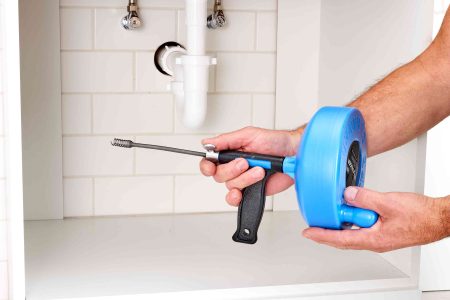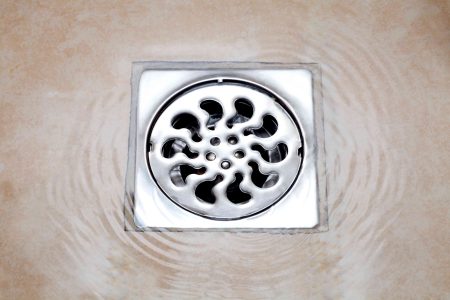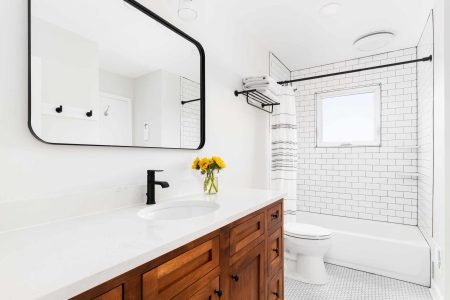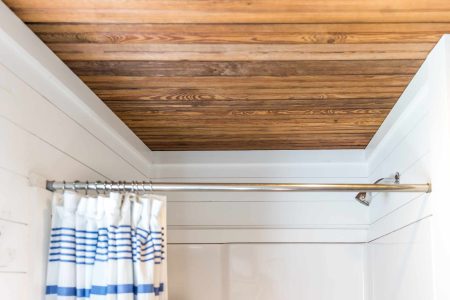Unclogging a shower drain is often as simple as using safe materials like baking soda and vinegar or plunging or snaking it. When water backs up in the shower, try any of these quick DIY methods to unclog the drain before calling a plumber.
Before You Begin
Remove standing water before unclogging the shower drain. Do this for all methods except the plunger method, which needs standing water to create force in the drain. Use a wet-dry shop vacuum (no filter) to remove the water or absorb it with bath towels.
Detach the shower drain grate and any hair-catcher filters. If this is a tub/shower combination, open the drain stopper.
How to Unclog a Shower Drain With Vinegar and Baking Soda
Vinegar and baking soda can unclog a drain with the force of bubbling carbon dioxide. The mixture expands to dislodge shower drain clogs.
- Heat the water: Heat one cup of water in a tea kettle or microwave.
- Pour dish soap: Squirt a generous amount of grease-cutting dish soap in the drain.
- Add hot water: Slowly pour one cup of hot water into the drain. Hot water and dish soap help to loosen hair and soap deposits.
- Add baking soda: Pour one cup of baking soda into the drain. Direct the baking soda in the drain with a funnel to avoid spilling elsewhere.
- Add vinegar: Pour one cup of distilled white vinegar into the drain. The mixture will fizz in the drain; this is normal.
- Heat water: While the mixture works in the drain, heat two cups of water.
- Flush with water: Carefully pour two cups of hot water into the shower drain. Then, turn on the shower tap to assess whether the shower is now draining freely.
Want more home reno project tips and inspiration? Sign up for our free daily newsletter for the latest how-tos, reno guides, and more!
How to Unclog a Shower Drain with a Plunger
Unclog a shower drain with a plunger the same way you would unclog a sink with a plunger. Plungers either pull the obstruction up and out (for manual removal) or loosen and push the obstruction further down, generally causing the drain to flow again.
The best plunger to use for showers is a standard cup-style drain plunger, not a bell-shaped toilet plunger.
- Cover the overflow opening: For bathtub/shower combinations only, remove the overflow opening cover with a screwdriver and cover the opening with duct tape to make it airtight. Skip this step for showers with pans because they have no overflow openings.
- Add water: Add two inches of water to the shower or tub. If there is standing water already, there is no need to add extra water.
- Position the plunger: Place the plunger at an angle in the water to fill the cup with water. Tilt the plunger so the handle is vertical again, with the plunger’s lip sealing against the tub floor.
- Plunge the drain: Thrust the plunger firmly while maintaining the cup’s seal on the tub floor.
- Continue to plunge: Thrust the plunger up and down several more times. If the cup slips out of place, refill it with water and place it back in position.
- Remove obstruction: Remove the plunger. Grab and remove hair clogs and obstructions that float up before they go back down the drain.
- Test the drain flow: Remove the tape seal on tub/shower combinations. Turn on the hot water and assess the drain’s flow rate.
How to Unclog a Shower Drain with a Plumber’s Snake
Clear a clogged shower drain with a plumber’s snake to remove obstructions that cause the water to back up. A plumber’s snake snags obstructions like hair, hair ties, and solid chunks of soap, and pulls them up for manual removal.
Be sure to use a drain snake, not a toilet snake (also called a closet auger or toilet auger).
- Place the auger in the drain: Place the spiral auger end of the drain snake in the shower drain opening. If this is a shower/tub combination, remove the overflow plate and run the auger into the overflow drain, not the tub drain.
- Extend the cable: Slowly rotate the handle on the snake to spin the cable in the drain opening.
- Continue augering the drain: Let the snake feed itself into the drain rather than forcing it down.
- Pull the cable out: After augering about one to two feet of the drain, pull the cable straight out (do not spin it to remove it). Many obstructions are found in the first foot or two.
- Re-auger the drain: If augering a short distance doesn’t work, try again—this time, augering five to 10 feet down the drain. Pull the snake slowly out, being sure not to rotate it. If there is a soft obstruction, it will be found on the end of the cable.
- Replace the grate: Replace the drain grate and run hot water to test the water flow.
How to Unclog a Shower Drain with a Hair Removal Tool
Some shower drains can be unclogged with a hair removal tool. This long, thin strip of plastic has multiple barbs and is effective at getting hair out of shower drains.
- Push the tool in: After removing the drain grate, push the hair removal tool into the drain. Push straight. Do not rotate it.
- Push through obstructions: When you encounter an obstruction, try to push through it. The barbs need to push a few inches through the obstruction to grab it.
- Pull out: When the handle nearly reaches the tub drain, stop pushing. Slowly pull the tool straight up.
- Dispose of the tool: Leave the obstruction on the tool. Dispose of the entire tool and obstruction.
When to Call a Professional
Call a licensed plumber to unclog the shower drain if you have already tried simple options without success. If you notice a foul odor coming from the drain, this indicates a sewer clog. Call a plumber for help here, too.
Shower pans have low thresholds and can hold only a few gallons of backed-up water before spilling onto the bathroom floor. So, if the shower pan is completely clogged and you cannot clear it by yourself, call a plumber immediately.
Tips for Keeping Your Shower Drain Clog-Free
A few simple preventative maintenance tasks go a long way toward keeping your drain clog-free.
- Attach the drain cover: Ensure that the metal drain cover remains attached at all times. It may have become displaced or removed for cleaning.
- Add a hair-catcher: Attach a silicone or metal microfilter to the top of the drain cover. This $5 to $7 device catches more hair than the drain cover since its holes are smaller.
- Flush the drain: Regularly flush the drain with drain cleaner. The best drain cleaners are biodegradable and enzyme-based since they won’t damage the drain pipes.
- Use a hair remover: Run a plastic barbed hair remover down the drain regularly, even if it isn’t clogged. Regular use removes hair that can accumulate and form clogs over time.
- Switch to liquid soap: Use liquid bath soap instead of bar soap, as bar soap is more likely to create thick soap scum and gunk.
Read the full article here








